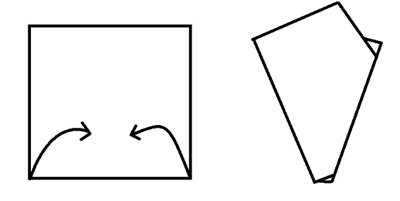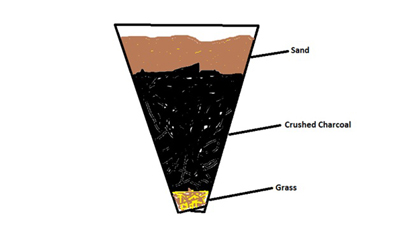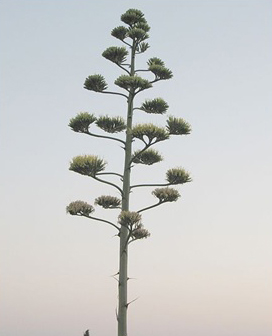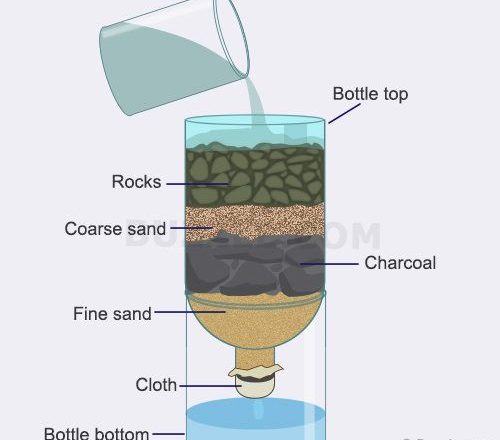Learning to make a water filter is a valuable survival skill. A thousand years ago people could wander through North America drinking any water that they pleased. Unfortunately that is not the case anymore. Much of our water contains contaminants and pathogens such as giardia that may cause extreme illness – illness that could easily prove fatal in a survival situation.
Unless you are sure that the water you are drinking is safe, then you better purify it by whatever means necessary. Modern water filters with micron-sized pores are very effective at filtering out giardia and if you don’t have one, boiling is the next best option. If your water contains lots of sediments and/or strong odors, you can construct a primitive water filter using natural materials to remove sediments and odors before boiling. Please note that natural filters alone do not remove pathogens.
The first step to make a water filter is to find or make a container that will hold everything together. If there is garbage around (which unfortunately, there usually is) then you may be able to find a 2 liter soda bottle. Cut off the bottom of the bottle, turn it upside down, and it will work great for containing the filter materials. If you don’t have a soda bottle, you can make something similar out of bark.

Many trees have bark that is pliable enough to work for this project. elm, pine, birch, cedar, and basswood are a few that work quite well. It doesn’t have to be a flawless piece, just one flexible enough to shape into a cone.

Once you shape a container into a cone, you’ll need to tie it into that shape with rootlets, strips of bark, or whatever is at hand. You may want to trim the top of the cone too, to make it more even.

Next you will stuff the bass of the cone with a thick ball of grass. The grass will hold in all the material above it. Fill most of the cone with charcoal, and top it off with a layer of sand. The sand acts to filter the big particulate material before they reach the charcoal.
Let’s talk about charcoal
Charcoal is produced when wood becomes really hot but doesn’t have enough oxygen to turn it into ash. So if you want to make charcoal, make a fire, let it burn into a hot bed of coals, then cover the coals with dirt and allow it to cool.
Activated Charcoal
Activated charcoal is used for many different things in our modern world. It has replaced regular charcoal in water filtration systems, it is used to absorb chemicals, toxins and gasses, and it is sold in health food stores in pill form for its many medicinal uses. It can be very effective treatment for ingesting poison. The high porosity of the charcoal can help to absorb the poisons and allows it to pass through a person’s body safely. It can also be effective treatment for bites from venomous snakes and spiders.
You may be wondering: what is activated charcoal? Well it is just regular charcoal that has been processed to increase its porosity. This is done chemically or physically. It is so porous that one gram of activated charcoal has a surface area of over 500 square meters! To physically activate charcoal you would have to pass steam over the powdered charcoal at 1,700 to 1,800 degrees F. Unfortunately that is probably not practical in a wilderness situation.
Regular Charcoal
Activated charcoal is amazing stuff, but consider when you make a water filter that regular charcoal has a long history of use in odor control and water purification (over 3,000 years). From 1500 B.C. to the 18,000s, regular charcoal powder was used to control the stench of rotting flesh. Ancient sea explorers scorched wooden water barrels to preserve drinking water on long voyages. During the days of the “wild West” the American Calvary used charcoal along with sand and gravel to filter swamp water for drinking. Regular charcoal still has phenomenal absorption abilities.
Other Possible Containers
I’m sure a person could invent hundreds of different containers to make a water filter from natural materials but in parts of the country, nature provides a perfect water filter container – agave stalks!

Agave grows in arid parts of the country and wherever it is growing, there is always an abundance of dry stalks that have fallen to the ground. These stalks have a spongy inside that is great to use to make a water filter. What I recommend is cutting a six foot section of stalk, splitting it down the middle and hollowing out all but the last six inches.

Fill four feet of the stalk with charcoal powder (leaving the top foot and a half to hold the water as it slowly percolates) and tie the stalk back together. Due to the amount of charcoal you could run the water through, this is successful method for primitively removing sediments and odors from water before boiling to kill the pathogens.
Experiment with how to make a water filter, be smart, be safe and good luck!
source : Connor O Malley



